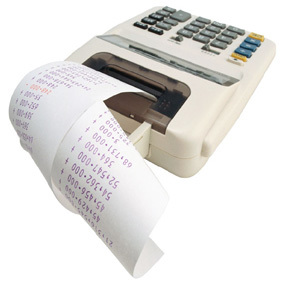
In order for a sole trader to be able to keep basic tax accounts certain conditions regarding the status of business accounts must be satisfied. Sales turnover should be under the vat threshold limit, a balance sheet not required, a business bank account not used and no employees employed. If the conditions are met then a simple income and expenditure statement is all that is required greatly simplifying the bookkeeping.
Self employed businesses are not required to maintain a balance sheet. If a balance sheet is maintained then to produce one the business needs to operate an accounting system based upon double entry bookkeeping and involving technical features such as debtors and creditors control accounts. Sole traders who do not need to produce a balance sheet can then maintain their basic accounting using single entry bookkeeping which is basically making lists of the financial transactions.
If a balance sheet is not produced the sole trader must keep a record of all capital expenditure items as part of the basic tax accounts to enable the capital allowances to be claimed each tax year. Receipts need to be retained as part of the basic accounts to enable the annual investment allowance to be claimed in the first year and writing down allowances in subsequent years.
More detailed financial records are required to be kept by the Sole Trader if they are vat registered. The vat threshold for the financial year starting April 2008 is £67,000. Part of the vat rules state that when a business is vat registered they should maintain an audit trail of transactions to support the vat return.
A sole trader does not have to operate a business bank account however if a business bank account is used then accounting records should be kept as the taxation authority, HMRC can ask to see details of the account. This inspection is to verify the transactions support the basic accounts produced. If a business bank account is not used then HMRC do not have a statutory right to view the sole trader personal bank account and that personal; account does not have to be a feature of the sole trader basic accounts.
When a sole trader has employees then as an employer a PAYE system is required which involves maintaining accurate wages records of employees, gross wages, income tax and national insurance deductions and net pay. Various PAYE records must also be maintained such as the working deductions sheet and also payslips must be issued to employees. The payroll records form part of the financial accounts of the sole trader who would actually be better called self employed if they have employees.
In the circumstances where a sole trader has no employees, is not vat registered and does not maintain a business bank account then formal accounts are not essential and a simple income and expenditure account statement can be produced. It is still essential that those sole trader basic accounts are supported with copies of invoices given to customers or records of amounts taken plus documentary evidence to support the payments made to suppliers.
On the sales side the basic accounting can consist of a list of the sales which when totalled produces the sales turnover of the business which is the income side of the income and expenditure statement. As not all sales may be received at the time of sale it is useful to keep a record of the date of the sale, the customer, amount and when and how much the customer has paid for credit control purposes.
Similar to the income side the expenditure can consist of a list of the amounts paid out to suppliers. It is advisable to perform a small amount of analysis of this expenditure as when reported on the self employed tax return the expenditure may need to be analysed according to the type of expense. All expenditure items claimed as business expenses should be supported with documentary evidence of that expense for basic tax purposes.
At the end of the financial year the sole trader income and expenditure account statement will state the total sales with the expenditure side being a list of all the expenditure by type of expense including any capital allowances claimed. Total the expenditure and deduct the total from the sales turnover to produce basic accounting record showing the net taxable profit.
A simple method of keeping the information to produce the income and expenditure account statement is to use an accounting spreadsheet with preset columns for sales and the expenditure types. The sole trader should also consider maintaining a separate list of the assets purchased as part of the basic tax accounts.
 Terry Cartwright qualified as a Chartered Management Accountant and Chartered Company Secretary in 1971. A successful business career followed as Head of Finance for major companies in the UK and several consultancy appointments. In 2006 he created DIY Accounting producing Accounting Software for self employed and small companies that use simple accounts spreadsheets to automate tax returns.
Terry Cartwright qualified as a Chartered Management Accountant and Chartered Company Secretary in 1971. A successful business career followed as Head of Finance for major companies in the UK and several consultancy appointments. In 2006 he created DIY Accounting producing Accounting Software for self employed and small companies that use simple accounts spreadsheets to automate tax returns.
Categories
Sole Trader Basic Accounting
A sole trader in the UK can operate a very basic accounting system. Provided supporting evidence is retained to show the basic accounts are realistic and the income and expenditure statement accurate for basic tax purposes sophisticated accountancy, debits and credits are not required. Basic accounts for sole traders do not require the production of a balance sheet.